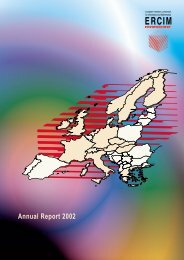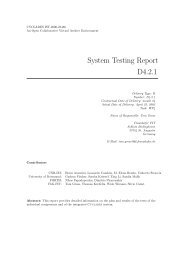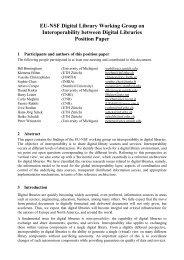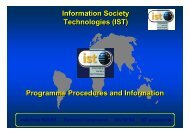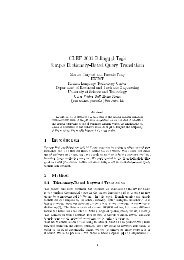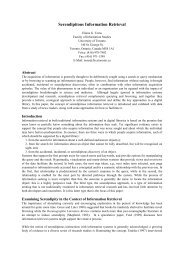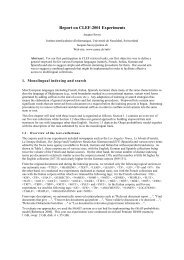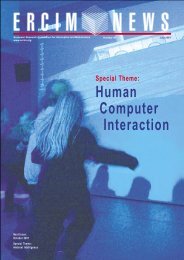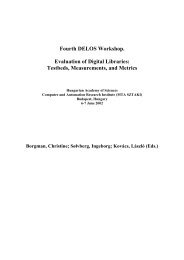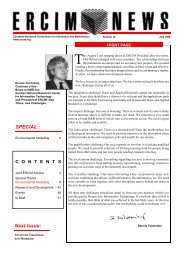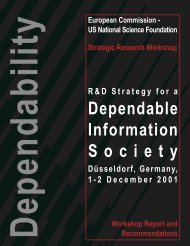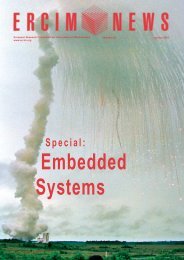Towards a Platform for Widespread Embedded Intelligence - ERCIM
Towards a Platform for Widespread Embedded Intelligence - ERCIM
Towards a Platform for Widespread Embedded Intelligence - ERCIM
Create successful ePaper yourself
Turn your PDF publications into a flip-book with our unique Google optimized e-Paper software.
SPECIAL THEME: <strong>Embedded</strong> <strong>Intelligence</strong><br />
Ecological Approach to Smart Environments<br />
by Veikko Ikonen<br />
The project EASE (Ecological Approach to Smart Environments) aims to offer<br />
more profound analysis and research-based evidence to support the design of<br />
smart environments. Furthermore, the aim is to analyse the design issues<br />
related to the smart environments and offer some general guidelines <strong>for</strong> the<br />
design of smart environments in different application areas.<br />
The technological shift of computing,<br />
including applications and services<br />
directed to two dimensions, embeddedness<br />
and mobility, has already changed a<br />
lot about our relationship to our environment<br />
(both social and technological).<br />
Technology has always been embedded<br />
in our living environment in some way.<br />
The technological infrastructure has<br />
been fading from our sight as technology<br />
has reached a more mature<br />
status. In the electronic and computer<br />
era the wires, base stations and servers<br />
are usually hidden and we see only our<br />
personal technical appliances. However,<br />
the embeddedness of technology is now<br />
shifting from particular, computer-situated<br />
spaces, towards a computers-everywhere<br />
philosophy. The idea that we<br />
have a place where our interaction with<br />
our environment is supported by computers<br />
is changing. Soon we will have<br />
technological components (communicating<br />
with each other) everywhere, out<br />
of our sight, obtaining and utilising<br />
in<strong>for</strong>mation gathered from the environment.<br />
The increasing mobility of in<strong>for</strong>mation<br />
and communication technologies has<br />
also changed our relationship with our<br />
environment. With mobile computers we<br />
can carry lots of data with us (eg books,<br />
music and photos), but at the same time<br />
we can also create new expressions of<br />
ourselves and share this in<strong>for</strong>mation<br />
with others. This connection to the<br />
global network enables continuous in<strong>for</strong>mation-sharing<br />
and communication in<br />
various ways. When these two dimensions<br />
work together, when the person<br />
with mobile technology interacts with<br />
the situated smart environment, we are<br />
approaching the area of ubiquitous (or<br />
pervasive) computing, also called<br />
ambient intelligence.<br />
32 <strong>ERCIM</strong> News No. 66, July 2006<br />
Even though research in the area of technologically-embedded<br />
intelligent environments<br />
is expanding very fast, the<br />
development of design approaches, other<br />
than technology-driven ones, is still in its<br />
early stage. The methodologies commonly<br />
used in designing and evaluating<br />
in<strong>for</strong>mation and communication technologies<br />
have been quite goal-oriented,<br />
but new approaches and methods have<br />
been introduced and tested along the<br />
way. Design principles <strong>for</strong> intelligent<br />
environments have been published, but<br />
in these statements the technological<br />
issues are also emphasised to a greater<br />
extent. More profound co-operation<br />
Training with smart technologies.<br />
between different designers, developers<br />
and researchers is needed in order to put<br />
<strong>for</strong>ward new theories and methodologies<br />
that will help to develop solutions that<br />
naturally support people in their living<br />
environment and take into account both<br />
the complexity of the systems and tech-<br />
nological aspects as well as social, ethical<br />
and cultural issues.<br />
With EASE, we have brought together<br />
participants from different fields in<br />
designing computerised smart environments<br />
and especially those who deal<br />
with human technology interaction in<br />
this research area. The aim of the project<br />
is to identify, model and evaluate the<br />
ecology of an intelligent environment<br />
from the perspectives of human, technological,<br />
environmental and different<br />
design methodologies. We are specifying<br />
the attributes and characteristics of<br />
good smart environments as well as<br />
identifying and developing suitable<br />
methods <strong>for</strong> the design, implementation<br />
and introduction of technologicallyenhanced<br />
smart environments. The participants<br />
make up an interdisciplinary<br />
team, which is vital in order to attain<br />
truly holistic knowledge of the phenomena.<br />
The project pools the knowledge<br />
that research partners have accumulated<br />
in other projects. Our aim is to<br />
cultivate this know-how and to develop<br />
and present it in a more general manner<br />
<strong>for</strong> designing future smart environments.<br />
Illustration by Pertti Jarla.



